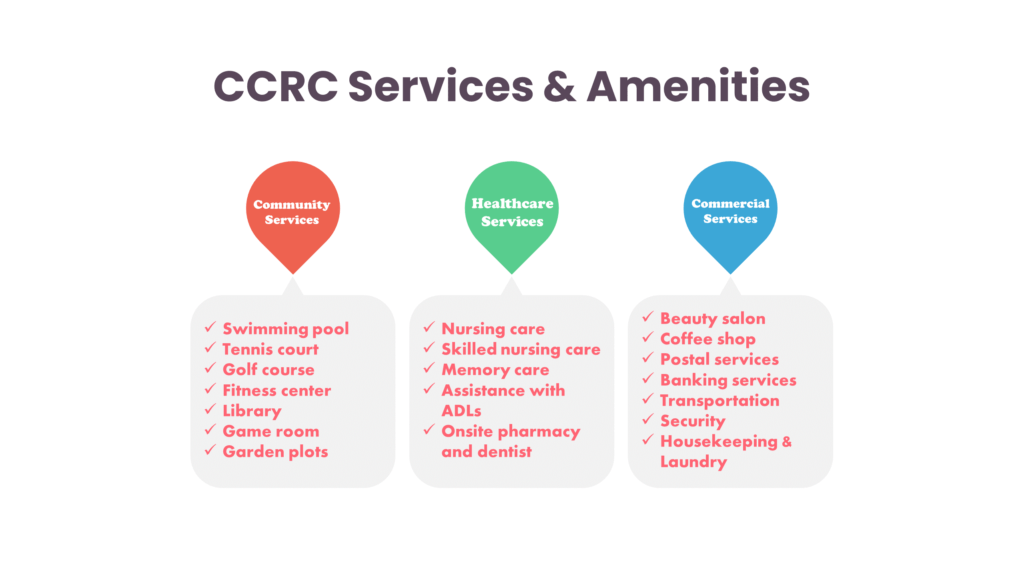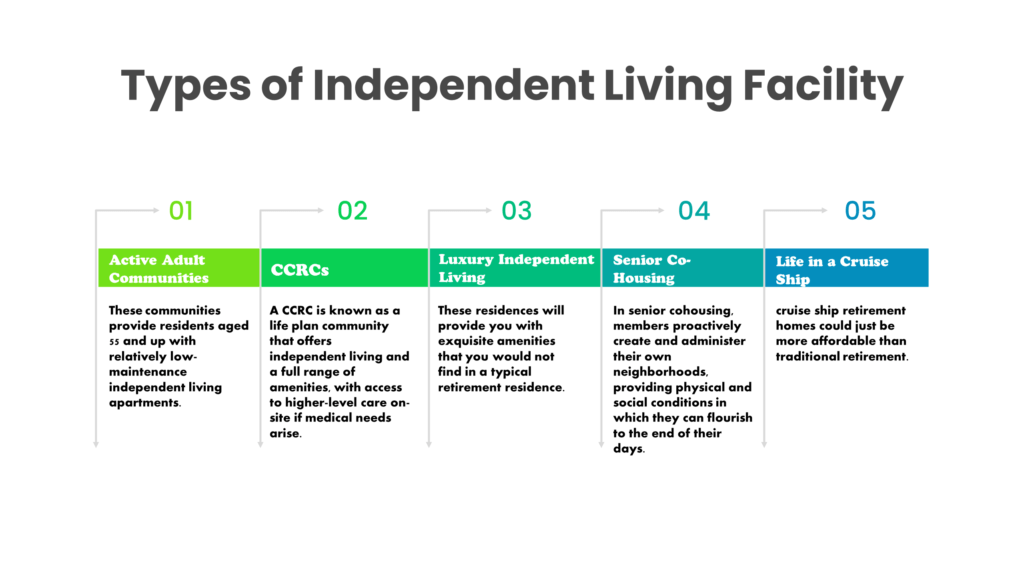What Is Independent Living?
Independent living refers to retirement housing where seniors live with other senior companions in the same community. Here, they do not need daily assistance with personal activities as they are mostly healthy and capable of managing ADLs. Independent living facilities have other names like senior living or retirement communities. And there are many different types of independent living facilities available for seniors too, which is the main focus of our reading here.
Residents of an independent living community live primarily freely in a residential setting, participating in communal life and enjoying the comforts of individual housing, usually apartments or villas.
The independent living services offer a variety of conveniences and programs that make life easier than it would be if you were living alone. Living independently is carefree and hassle-free, from housekeeping to meal preparation and home upkeep. With a variety of physical fitness courses, traveling, educational and cultural activities, and the ability to live life well with people who feel like family, senior living communities also foster healthy aging.
Senior Independent Living is for seniors who do not require personal help but would like to relocate to a community to make their lives easier. They can spend quality time with family or friends, work on hobbies or interests, and live freely without the need for additional care, which is all too often got in independent assisted living these days.
5 Types of Senior Independent Living Facilities Available for You
You will have a few housing options if you select independent living. The type of available housing ranges from a private studio to a large two-bedroom apartment. Depending on the community, homes may be available for purchase or rent. There are significant distinctions between the various types of communities available to you.
1. Active Adult Communities
Active adult communities are also known as age-restricted communities. The Fair Housing Act governs age-restricted communities, which are only open to people aged 55 and up. According to the act’s regulations, 80 percent of age-restricted units must be occupied by someone over the age of 55. In addition, minors are not permitted to live in the neighborhood.
A country club atmosphere is standard in age-restricted communities. A golf course, tennis courts, clubhouse, and swimming pools, among other high-end amenities, may be found.
These communities provide residents aged 55 and up with relatively low-maintenance independent living apartments. Active adult communities are divided into two categories:
- Age-restricted — The Fair Housing Act requires that at least 80 percent of households have at least one member over the age of 55.
- Age-targeted — Active adult communities cater to people in their fifties and sixties, although they aren’t confined to that demographic.
The 55 and over communities can include apartments, single-family houses, patio homes, townhouses, condos, and mobile homes – which can be rented or owned. These neighborhoods are frequently located near shopping centers, restaurants, and other local attractions.
Some benefits of active adult communities
- Easier to enjoy everyday life
- Less maintenance works
- Appealing zero-maintenance living
- Perfect-sized living space
- Surrounded by like-minded and friendly seniors
2. Continuing Care Retirement Communities (CCRC)
A CCRC is known as a life plan community that offers independent living and a full range of amenities, with access to higher-level care on-site if medical needs arise. Residents have the stability of remaining in their homes because of this continuum of care. Seniors can choose from three types of contracts in a CCRC:
1. Extensive contracts, also known as Type-A contracts, give residents lifetime access to independent living, assisted living and Skilled Nursing Facilities (SNFs)- monthly fees due to a requirement for a higher level of care.
2. Residents receive a discounted payment for independent living and a short duration of assisted living or skilled nursing care under modified contracts. If the person needs more care beyond that time restriction, they will be charged on a daily basis.

Benefits of living in CCRCs
While monthly maintenance contracts vary depending on a senior’s retirement home, most CCRCs offer a variety of services that older individuals require and value, including:
- Nutritious meals and snacks
- Transportation
- Lawn care and gardening
- Garbage and snow removal
- Regular housekeeping
- Laundry
- Health monitoring services
- Emergency call monitoring
- Security and supervision
3. Luxury Independent Senior Living
High-end services, personalized amenities, and a complete calendar of social events are all available to retirees in luxury senior living. In addition, these residences will provide you with exquisite amenities that you would not find in a typical retirement residence. Among these extravagances are:
- Beautiful lounges with fireplaces
- Room service/in-suite dining
- Exercise rooms and wellness centers
- Bars and pubs
- Sophisticated game rooms
- Indoor and/or outdoor pools
Benefits of luxury senior apartments
Even though moving away and coping with your emotions or reducing your life can be exhausting, you should be able to enjoy your life after this initial hiccup. Moving into a luxurious environment should make a move far more appealing than it would be in a different type of property! The excellent experiences that many residents had at luxury retirement residences astounded them. Even if they experience an initial shock, it passes off fast.
Because luxury residences have so many resources, they can keep you occupied for a long time. While your new way of life should be restful, you’ll have plenty of opportunities to keep your mind and body engaged. Senior exercise centers, social engagement, and various cognitive games can all help you maintain or improve your health. However, rest assured that, while the personnel at these homes will urge you to participate in activities, they will not force you to do so. You will have complete autonomy.

4. Senior Co-Housing
Senior cohousing transforms the tried-and-true cohousing paradigm into a revolutionary social innovation that views aging as a source of opportunity.
In senior cohousing, members proactively create and administer their own neighborhoods, providing physical and social conditions in which they can flourish to the end of their days. Participation in an Active Aging study group fosters community, which in turn fosters the construction of homes and a shared dwelling. People own their own homes, but they share a huge common house and meals, and they co-care for one another, allowing them to age in place at no cost to the system. For future exigencies, the common house has a caregivers suite.
Each community is unique and takes time to organize and build, however here are some examples:
- A group of attached or single-family dwellings arranged around a central courtyard with a common house, a lounge, and recreational facilities.
- Private suites in a single house with communal areas and a kitchen. A suite for a live-in caregiver could also be included.
Benefits of choosing senior co-housing
Senior cohousing was created to provide older persons with a cost-effective living arrangement. As a result, it can encourage sociability, co-caring or neighborly help for health and personal needs, and the ability to keep independence and control over their lives.
With the number of baby boomers on the rise, seniors cohousing may be an alternative for those who wish to take steps now to stay independent and avoid having to rely on their offspring or move to a retirement facility in the future.
5. Life in a Cruise Ship
Have you ever considered retiring aboard a luxury cruise ship? When compared to living in a retirement home or assisted living facility, cruise ship retirement homes could just be more affordable than traditional retirement.
There are two approaches to calculating the costs of retiring on a cruise ship. The first is the amount if you book multiple cruises in a row and transfer from ship to ship. Scheduling long-term cruises is an excellent alternate for booking back-to-back voyages or purchasing a condo.
Benefits of independent living in a cruise ship
So, why do senior citizens flock to luxury cruise ships? You must follow the costs first. Cruise ships may be comparable to or even less expensive than an assisted living facility or nursing home. According to CNBC, a day on a Princess Cruises costs around $135. A day in a care home’s private room costs $253. When you compare the monthly expenditures, Princess Cruises comes up to roughly $4,200, while the private room at the nursing home is about $8,000. On the other hand, assisted living facilities to cost $119 per day, which is slightly less than the cruise ship.
Aside from the possible cost reductions, there are the cruise ship’s amenities to consider. Pools, exercise facilities, lounge rooms, and hot tubs are all available on today’s ships. In addition, fine meals, seminars, entertainment, housekeeping, and other amenities are all available. As a result, retirees who choose this lifestyle can be pampered on a daily basis in addition to traveling across the world and seeing unique locales. It’s no surprise that an older adult who lives aboard a ship has a superior quality of life, according to research published in the Journal of the American Geriatrics Society.
Another major factor driving this transition could be healthcare availability. The publication points out that most assisted living homes do not have doctors on call 24 hours a day, seven days a week. However, cruise ships feature onboard medical services, including physicians and nurses who reside on board. As a result, they’re capable of dealing with a wide range of medical emergencies. Although a cruise ship is not suited for someone with severe or persistent health issues, it can be a good option for many healthy seniors.
Independent Living Programs for Seniors to Benefit from
Seniors can get benefits from different independent living programs as well. These programs are equipped in helping seniors with low-income or who require help in finding the best independent living for them.
HUD Congregate care housing Program
A congregate care facility is primarily for 55 and older people who require little or no assistance with daily activities and do not require state-issued licensure. The HUD provides grants to states, local government units, Tribally Designated Housing Entities (TDHES), public housing authorities (PHAs), and local nonprofit housing sponsors to provide meals and other assistance frail elderly and disabled residents in sheltered accommodation. It’s a project-based program, not a tenant-based one.
This program provides the following services to seniors:
- Prevents frail elderly, non-elderly disabled, and temporarily disabled people from being institutionalized prematurely and unnecessarily
- Offers a variety of innovative approaches for delivering meals and nonmedical supportive services while utilizing existing service programs
- Fills gaps in current service systems
- Ensures that funding for meals and other programs necessary for independent living is available
The village movement
The Village Movement is a grassroots initiative that brings together essential services for senior citizens. Villages are one of the most promising solutions to the looming “Aging Revolution” conundrum. The Village Movement was first initiated in 1999 by a group of older people who wished to remain in their own houses while participating in local social events.
Members pay annual dues in exchange for subsidized access to a network of services. Home healthcare, grocery delivery, and home maintenance are examples of these services. Furthermore, the village frequently promotes local social activities that bring together the small communities. Across various communities in the United States, seniors will find hundreds of villages.
Benefits of the village movement
Many seniors join the village movement for its social attributes. This involves scopes to be a part of dozens of activities every month. In addition to this, the dues of the tangible services are tax-deductible. This is because seniors stay in the village with nonprofit status. As a result, many seniors are opting for the village services making it popular day by day. Within a few days, you will quickly become a member of the village, and every peer will be able to help each other lead a better social life.
Smart Aging Trend for Senior Care Transition
Technology has made our life more comfortable than ever before in today’s world. Thus, we can use different initiatives from investors and communities to make smoother senior living transition for seniors with the use of technology. As the next wave of seniors considers senior living options, we may anticipate even more push toward technology solutions in 2022.
This transition is a component of a senior living trend known as “smart aging,” which refers to AI-powered technology that aids older individuals in daily activities. Voice technology integration in the community and medical fields is expected to grow as part of the smart aging trend.
Conclusion
The primary difference between independent living and other senior care types is the level of care needed by seniors. In an independent living facility, the primary purpose of seniors is to live life with minimal supervision and maximum independence. Therefore, they require special services, amenities, and social activities to have a happy and eventful post-retirement life.
Active adult communities are designed for seniors who are still relatively active, while CCRCs are perfect for seniors who want to age in place. Luxury senior living apartments offer high-end amenities and added level of care with extra cost, while senior co-housing and cruise ships cater to unconventional yet affordable living options for older adults. Thus, the design of every type of independent living facility caters to senior requirements and needs.
If you are contemplating which to pick for yourself, BoomersHub is here with local advisors. We can help and support you in making the decision that best suits your preferences. Reach out to us to avail our services by calling at +(877) 409-0666 or emailing us at info@boomershub.com.
Frequently Asked Questions
What is the average cost of senior independent living?
The average cost of senior independent living ranges from $1,500 to $6,000 per month. However, some factors that can affect the cost include the size of the community, location, the level of care offered, and amenities offered.
Are independent living facilities tax deductible for seniors?
Independent living expenses for seniors typically do not qualify for a tax deduction unlike many other senior living options. However, some living expenses may qualify for the medical tax exemption.
How do you qualify for senior independent living?
Seniors can move to independent living if they have the financial resources and support system in place. Usually, seniors who live in independent living are self-sufficient and do not need assistance with their day-to-day activities. However, it is important to note that every situation is different and that you should speak with a senior care specialist to determine if independent living is the right option for your loved one.
How restrictive is independent living for seniors?
Independent living is not very restrictive for older adults. In fact. It provides the most freedom out of all other senior living options. However, the facilities have certain rules and regulations about who can live there. For example, age restrictions, restrictions on seniors with disabilities, or other health problems.
How to choose an independent senior living community?
To choose the right independent living facility, determine your requirements and what kind of living arrangement and amenities you want. Once you have a better idea of what you are looking for, you can begin researching communities in your area. Make sure to check the costs associated with each option and choose the one you can afford. Also, it is crucial that you make an in person visit to the facility before moving in. Get familiarized with the staff and talk to the residents to get honest opinions about the community.
What is the difference between independent living and senior apartments?
The senior apartment is the perfect place for those high-quality living with plenty of social opportunities. On the other hand, independent living communities offer slightly higher levels of senior care and access to healthcare that may make it easier on you when taking these necessary steps into old age!


1 comment
Modern seniors and retirees will have plenty of decisions and considerations to make when it comes to their senior homes. Currently, there are more than five choices on the table, but two of the most popular ones in the senior community are independent living and assisted living. Transitioning to a senior living community, no matter what kind or type, is already a challenge on its own. You have to adjust to a new environment, with new people and a unique set of rules. However, these short-term adjustments are far more pleasant than living and aging alone. Seniors, even those in good health and condition, can’t risk aging in place for safety, security, and health reasons. Living with your family may work for you and them for a while. But sooner or later, you will want to regain that sense of independence and purpose that this arrangement cannot fulfill. So, if you ever find yourself in need of a senior living community, then don’t hesitate to read on below about two of the most famous kinds of senior homes. Here is everything you need to know about independent and assisted living and how to choose between them.
Comments are closed.